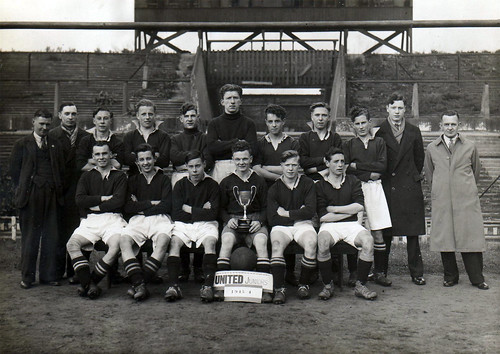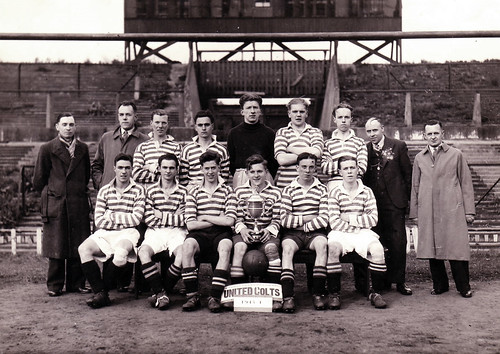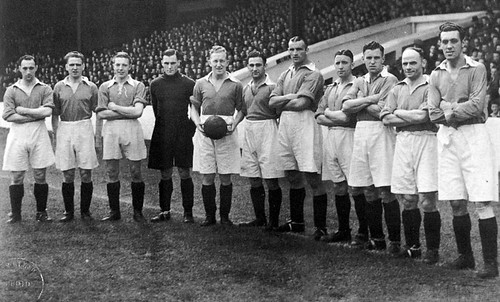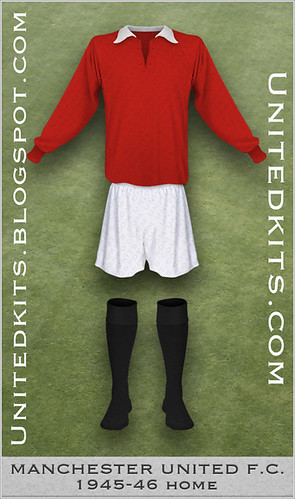On September 3rd, 1939, war was declared. The Football League was suspended the following day, although a system of regional leagues and cup competitions was established soon afterwards.
United took part in the Western Region War League during 1939-40, where they finished in fourth place. It was to have been the first Football League season where all teams were required to wear numbered jerseys after the FA had made them compulsory following a number of seasons of experimentation. Presumably clubs wore numbered kits in the regional leagues too, but the first match in which United's players adopted numbered shirts is currently a mystery.
Despite a number of famous names - Such as the great Stanley Matthews - appearing as guests for United during the war years, very few photographic records exist of the time. In fact, the only other period with such scant photo evidence to use for our purposes is the pre-1900s Newton Heath era.
Due to the onset of clothes rationing, we can only presume that the club continued to outfit the players in the kits worn in the years prior to the war, perhaps with numerous repairs and individual kits being supplied to replace those that were beyond such measures. It is very unlikely that a whole new set of kits would have been purchased during this time.
The few photos that we do have are of the MUJAC teams of 1943-44. Although in later years they wore slightly different jerseys than the first team, here they are wearing the same kits that the senior players took to the pitch in during the late 30s, albeit in very poor condition!:
United took part in the Western Region War League during 1939-40, where they finished in fourth place. It was to have been the first Football League season where all teams were required to wear numbered jerseys after the FA had made them compulsory following a number of seasons of experimentation. Presumably clubs wore numbered kits in the regional leagues too, but the first match in which United's players adopted numbered shirts is currently a mystery.
Despite a number of famous names - Such as the great Stanley Matthews - appearing as guests for United during the war years, very few photographic records exist of the time. In fact, the only other period with such scant photo evidence to use for our purposes is the pre-1900s Newton Heath era.
Due to the onset of clothes rationing, we can only presume that the club continued to outfit the players in the kits worn in the years prior to the war, perhaps with numerous repairs and individual kits being supplied to replace those that were beyond such measures. It is very unlikely that a whole new set of kits would have been purchased during this time.
The few photos that we do have are of the MUJAC teams of 1943-44. Although in later years they wore slightly different jerseys than the first team, here they are wearing the same kits that the senior players took to the pitch in during the late 30s, albeit in very poor condition!:
As well as the youth teams above winning the Wythenshaw League Junior Cup and the Rusholme League Amateur Cup, during the course of the war, the first team won the Lancashire War Cup in 1940/41 and 1942/43, the second League North Championship in 1941/42.
The main event during this time, however was the bombing of Old Trafford. The ground was located on the edge of the industrialised Trafford Park where munitions were being manufactured for the British armed forces. It was an obvious target for the Luftwaffe and was bombed many times. On the night of March 11th 1941, German bombs hit the Main Stand, causing a great deal of destruction. James Gibson was devastated, but Manchester City were quick to offer him a solution. United were to share with City, playing home games at Maine Road. From this arrangement, City made a good amount of money, charging a rent of around £5,000 per season as well as a cut of the gate receipts. For United, they really had no other choice but to accept these conditions and so Maine Road became the temporary home of the Reds until the summer of 1949.
Matt Busby officially became Manager of United in October 1945. He had previously played for rivals City and Liverpool (who had also wanted him to join them in a management role after the war) and captained Scotland during war-time friendlies. It was Louis Rocca (again) who had sought out Busby and recommended him to James Gibson. The Chairman and Busby met in Trafford Park in February of 1945 while the Scot was still with the Army Physical Training Corps. After Busby convinced Gibson to relinquish total control over team affairs to him (something practically unheard of at the time), the contract was signed there and then. Shortly afterwards while in Italy with his Army team, Busby met Jimmy Murphy and offered him the job as his assistant. The seeds of success had been sewn.
The Football League was not revived immediately after the war ended, instead the main competition in the 1945/46 season was the FA Cup, which for that season made each tie two-legged. United beat Accrington Stanley in their first tie but were knocked out by Preston North End in the next round.
During the 1945/46 season, they were photographed in shirts that look slightly different than those worn previously. I cannot decide whether they were of a different style or simply a repair job with laces used to replace missing buttons. Further photographs will be needed to confirm this.
The main event during this time, however was the bombing of Old Trafford. The ground was located on the edge of the industrialised Trafford Park where munitions were being manufactured for the British armed forces. It was an obvious target for the Luftwaffe and was bombed many times. On the night of March 11th 1941, German bombs hit the Main Stand, causing a great deal of destruction. James Gibson was devastated, but Manchester City were quick to offer him a solution. United were to share with City, playing home games at Maine Road. From this arrangement, City made a good amount of money, charging a rent of around £5,000 per season as well as a cut of the gate receipts. For United, they really had no other choice but to accept these conditions and so Maine Road became the temporary home of the Reds until the summer of 1949.
Matt Busby officially became Manager of United in October 1945. He had previously played for rivals City and Liverpool (who had also wanted him to join them in a management role after the war) and captained Scotland during war-time friendlies. It was Louis Rocca (again) who had sought out Busby and recommended him to James Gibson. The Chairman and Busby met in Trafford Park in February of 1945 while the Scot was still with the Army Physical Training Corps. After Busby convinced Gibson to relinquish total control over team affairs to him (something practically unheard of at the time), the contract was signed there and then. Shortly afterwards while in Italy with his Army team, Busby met Jimmy Murphy and offered him the job as his assistant. The seeds of success had been sewn.
The Football League was not revived immediately after the war ended, instead the main competition in the 1945/46 season was the FA Cup, which for that season made each tie two-legged. United beat Accrington Stanley in their first tie but were knocked out by Preston North End in the next round.
During the 1945/46 season, they were photographed in shirts that look slightly different than those worn previously. I cannot decide whether they were of a different style or simply a repair job with laces used to replace missing buttons. Further photographs will be needed to confirm this.





No comments:
Post a Comment